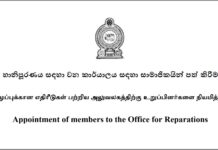More than 80 percent of Lankan families are eating less, or cheap food, owing to the prevailing crisis, says a report published by the World Food Programme on Lanka.
The report said more than 80 percent of Lankan families are eating cheap or limited food, and this has raised the risk of malnutrition.
“Based on a joint WFP and Department of National Planning rapid assessment, more than 80 per- cent of households are eating less preferred, cheaper food and/or limiting portion sizes, due to the rising prices, and reduced purchasing power. Households are consuming less diversified and nutritious diets, which fuels the risk of higher rates of malnutrition,” the report says.
It says reduced paddy harvests, from two consecutive seasons, will increase food insecurity.
The study points out that the price of imported rice has risen by 20 percent, due to the currency depreciation, and the cost of local rice varieties have increased by six percent due to the supply shortage and high cost of production.
This report, released on June 08, contains an analysis of food prices and commodity prices, in Sri Lanka, in April 2022, including price trends, inflation and key issues, within the current economic context.
It says: Continuation of escalating fuel prices and fuel shortages is anticipated with an impact across sectors, including food systems.
Poor performance of the ongoing Yala paddy cultivation is expected, impacted by fuel shortages and limited availability to fertilizers and pesticides. Reduced paddy yield, from two consecutive seasons, will likely drive an increase in household food insecurity.
Despite reaching record highs in April, there is likelihood of increasing inflation in the coming month as fuel prices continue to rise.
Overall inflation in April increased to 33.8%, up from 21.5% in March.
Food inflation accelerated to 45.1% in April year-on-year, up by +10.5% from March. This was driven by increased prices of rice, dhal, sugar and milk powder. Non-food inflation increased to 23.9% from 14.5% in March.
The Global Food Price Index demonstrates a small downward trend. April’s decline in the FFPI was driven by a considerable decline in the vegetable oil sub-index and a modest decline in the cereal price sub-index.
The price of imported rice has risen by 20% due to the currency depreciation. Cost of local rice varieties have increased by 6% due to the supply shortage and high cost of production.
The price of red lentils rose to a record high, +10% compared to last month and up by +170% from the same time last year.
The report has been prepared by the Research, Assessment and Monitoring unit of the World Food Programme, Sri Lanka. The analysis is based on data from various information source, including the Hector Kobbekaduwa Agrarian Research and Training Institute, Department of Census and Statistics, and FAO.











